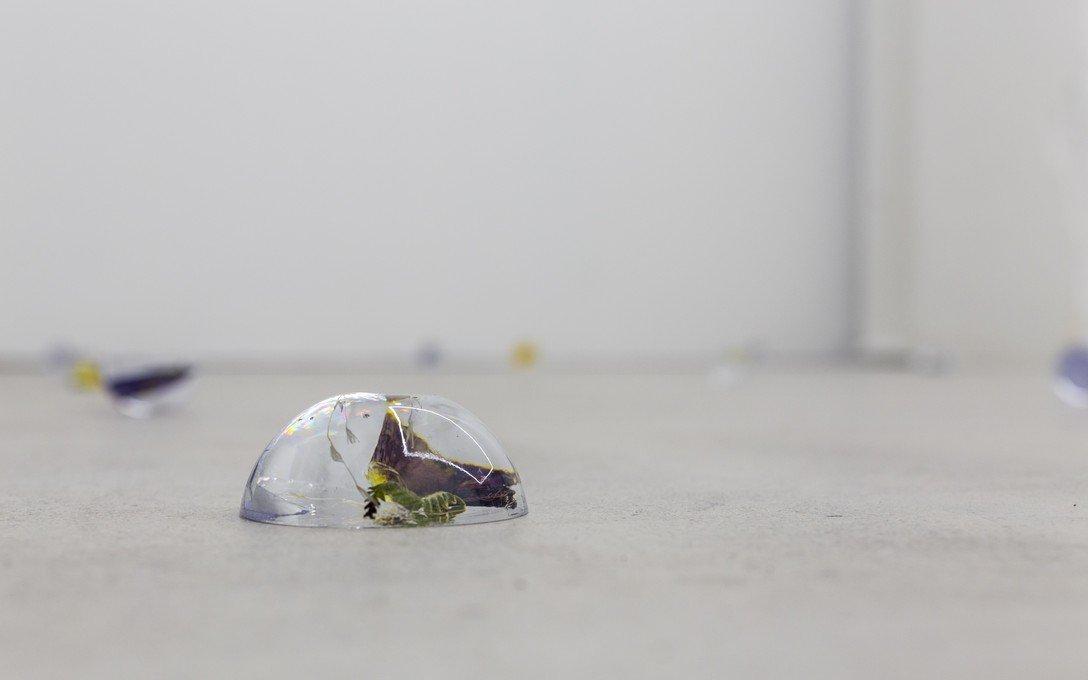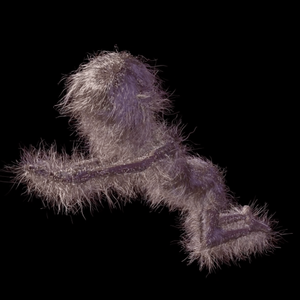In his book Crowds and Power (1960), which I come to through Gwyneth Porter, Elias Canetti describes rain as a crowd symbol, a natural phenomenon that summons the energy of a crowd and transforms it into myth, dream, speech and sound.(1) For Canetti, the motion of rain is intrinsically linked to its magical qualities. He writes, “rain falls in drops…it is seen as parallel streaks and the number of the falling drops emphasises the uniformity of their direction. There is no movement which makes more impression on man that that of falling… three senses at least—sight, hearing and touch—participate in the experience of rain, and to all these senses it is something multiple.”(2) Sorawit Songsataya’s exhibition Offspring of rain, at Enjoy Contemporary Art Space, has shared concerns with Canetti’s conception of rainfall. Offspring of rain presents sculptural components, moving image, and original composition in order to imagine how an encounter with the natural world can return to being something intimate. The show is the result of Songsataya’s research at the Mākara West Wind Farm. The moving image work Offspring of Rain—which also lends the exhibition its title—most explicitly illuminates Songsataya’s unravelling and reinterpretation of natural experience.
In the Western world, the everyday encounter with nature is usually mediated by technology, science and commerce. When the forecast is for rain, the symbol on the iPhone weather application seems to perfectly condense the mood that it brings. The weight of the rain cloud is heavy, bearing the load of an afternoon of precipitation. The chilly blue registers the driving force of the rain, carried by the wind, the way it stings cheeks, that it’s rarely misty or drop-like, but falls as sheets, dashes of water jetting in from the sky. The kind of rain that is illustrated by this symbol is conscious of the way the human day can be altered or transformed by the weather. The endearing quality of these tiny graphics reinstates the phenomenological dimension of the weather. I think about how the combination of weather and graphics can offer a gateway into understanding the way that Songsataya’s practice traverses documentation and animation.
The kind of rain that is illustrated by this symbol is conscious of the way the human day can be altered or transformed by the weather.
Offspring of rain begins with a small and chubby globe, bobbing up and down on the screen. The animated world falls, like a rain drop, into an similarly simply rendered pair of outstretched hands. Wobbling between cartoon fingers, Songsataya imagines Earth as liquid and malleable. The globe turns into a crystalline sphere, water to ice, and then its form changes again, to a pronged star, and to a crescent. In Gayatri Spivak’s book Death of a Discipline (2003), she writes that the conception of the world as a globe is way of insisting on our difference from the place where we live. Instead, Spivak proposes, Earth should be conceived of as a planet, and its population as planetary subjects. It is in this understanding of Earth that it becomes possible to reject an anthropocentric understanding of existence.(3)
The exchange that takes place in this fragment of animation— between earth, human, liquid and ice— realises Spivak’s proposition that the world and humankind are not separate entities. The playful nature of Songsataya’s animations are central to their critique of human exploitation of the natural environment.
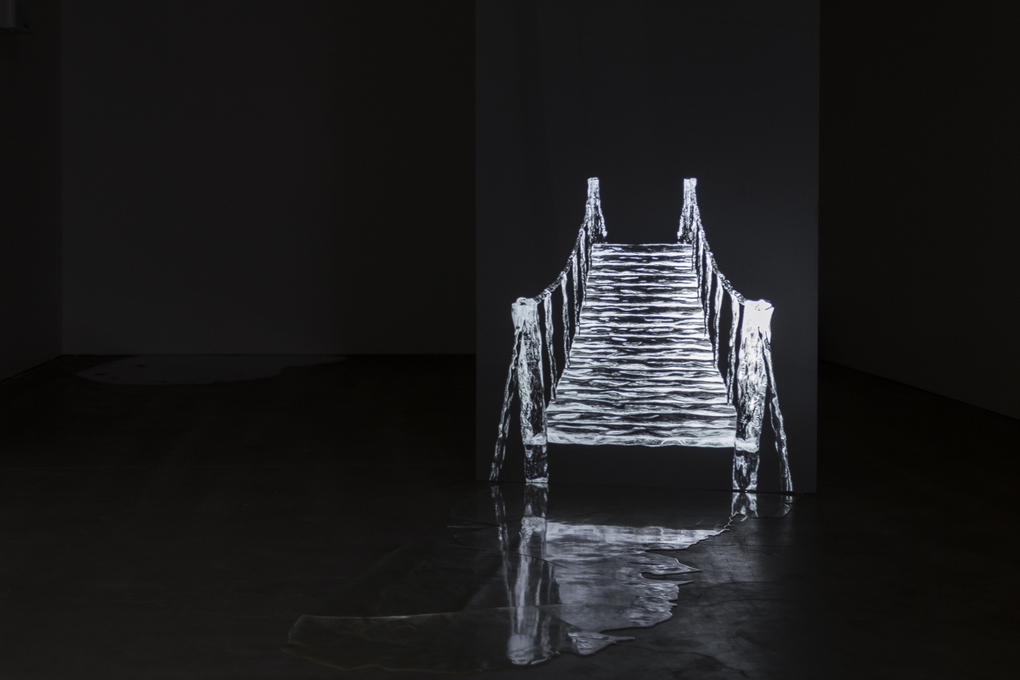
Offspring of rain (2019) Sorawit Songsataya, digital video, still, 10:00. Image courtesy of the artist
The moving image changes to a camera tracking through a rural landscape in Aotearoa, filmed from a car. Rows of pylons puncture the landscape. These industrial interventions into the landscape recall something of Edweard Burtynsky’s sickened sublime. The sublime has always been a way to insist on a state of alterity from the geographies we inhabit. However, unlike Burtynsky’s work, Offspring of rain allows for a synergy with the natural world. In the backdrop of the video, Songsataya has studded the sky with Pixar-like stars. These animated stars disturb any effect of the Industrial Sublime, by realising that to be planetary, in Spivak’s sense, is to be of stars and space too. They acknowledge the scientific transformation that has been enacted on the weather— harnessing, tracking, measuring, recording— by pointing to an alternative mode of perception. Rainfall has become about what can be extracted from it, rather than an admiration of cycles of condensation and evaporation.
As with the wind turbines of Mākara Wind Farm that Songsataya has also recorded, these industrial inclusions charge Offspring of rain with the politics of harnessing the weather as an energy source. Mākara’s Wind Farm is operated by Meridian Energy, the largest provider of electricity in Aotearoa. The notion of “farming” the weather draws attention to the cultivation of the environment that is necessary for such procedures to take place. Meridian Energy’s installation of wind turbines is another instance of the built environment encroaching on the natural world. It is difficult, if not impossible, to separate this activity from the ways in which colonisation is ongoing. However, in contemporary discourse, particularly from a Pākehā perspective, the conversations about colonisation focus on the physical land, but ignore how colonial dominance of Aotearoa seeps into every dimension of the environment. Meridian Energy has not only claimed the land area that their wind turbines have been planted on, but assert a mastery of the sky space too. As such, Songsataya’s focus on weather activity emphasises that the colonial Western mindset is predicated on ownership of any and all natural resources at hand.
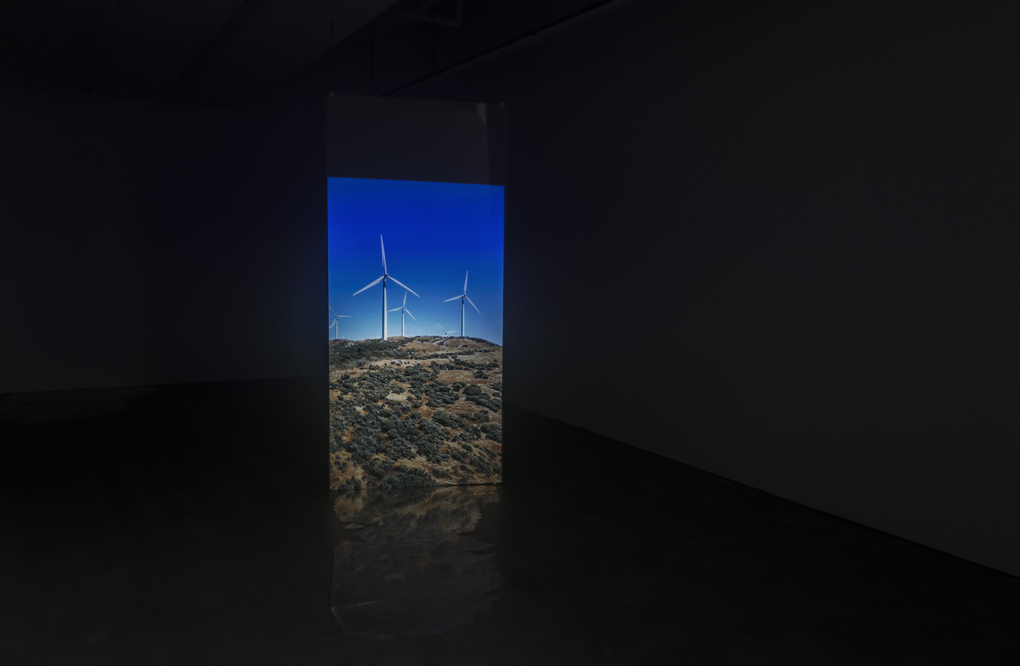
Installation view of Offspring of rain (2019) Sorawit Songsataya, digital video, still, 10:00. Image courtesy of the artist
Superficially, this harvesting of natural events appears primarily as a commercial endeavour, whereby the weather is a commodity that can be sold back to consumers to power their homes and lives. Yet, with the crowd as a vehicle for ideas, Offspring of rain also suggests that this type of natural exploitation is about more than the literal energy that water and wind provide. Instead, to collect and resell the weather does not only regard functional resources, but also ownership and distribution of the abstract qualities of meteorology. To return to Canetti, he writes that rain is the “crowd in the moment of discharge... the drops fall because they can keep together no longer.”(4) Falling rain is a moment of energy transferral, and so, analogously, it represents the moment where a crowd becomes a unified whole. Throughout Offspring of rain, the properties of a crowd are present, perhaps most pertinently in Songsataya’s inclusion of Antonia Barnett-McIntosh’s composition.
As the exhibition text notes, the Mākara Wind Farm has historically been a site for receiving and transmitting sound, in its capacity as Mākara Radio during the second half of the 20th century. The acoustics of weather are essential to a human experience of it, so it is fitting that at this location, cultivation of both weather and sound intersect. For Offspring of rain, Antonia Barnett-McIntosh composed an original score to accompany Songsataya’s moving image. The composition weaves through the space, a vaporous audio lingering in the visitor’s passage. To introduce the sound of rainfall into the exhibition, Songsataya and Barnett-McIntosh have recognised that it is unnecessary to replicate its rhythm— that instead, acoustics can be transposed. The score is tinkling and rattly and cold. The motion of weather patterns is present through its nebulous and experimental texture. Here, in the score, is where the falling happens. These moments, where the audio crescendoes, but in a hazy way, are echoed in the sculptural panes of resin that sit alongside the screen. The resin is cracked, and so together, this element and Barnett-McIntosh’s composition are able to signal to rainfall without being didactic. To go beyond rain as well, to think of the percussion wind enacts through foliage, or the absorbing silence of a snow blanket, sonic experiences of weather phenomena are encompassing. Rain falling heavily sounds a lot like the indiscernible and accumulated murmur of a crowd, and subsequently, being enveloped by something aural is a reminder of communality.
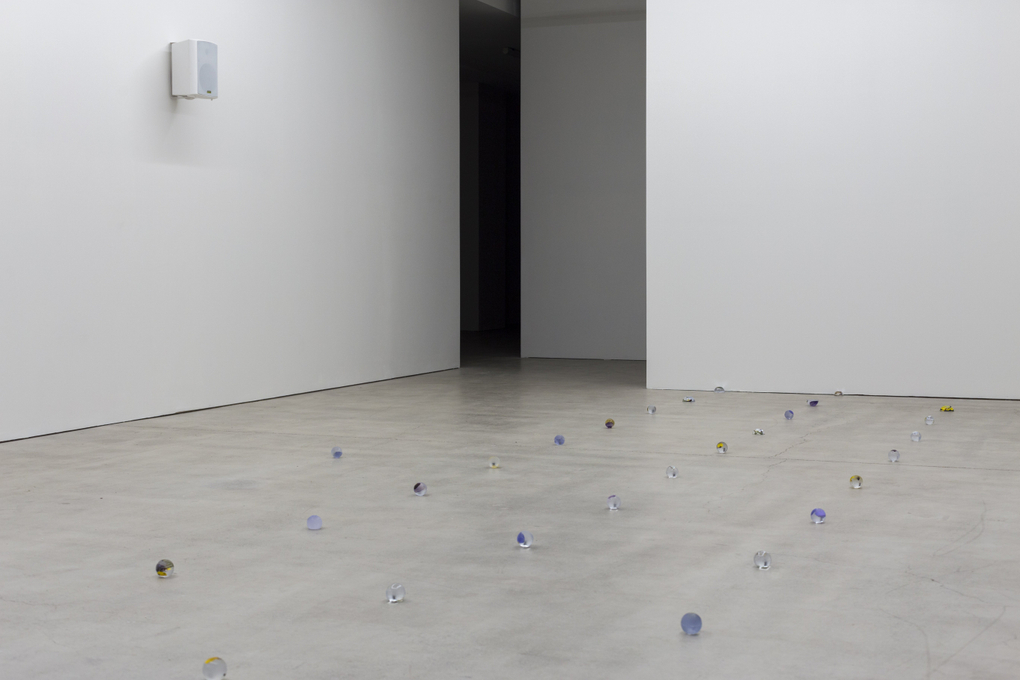
Installation view of Morning dew (2019) Sorawit Songsataya, cast resin and heat-pressed and dried plant material. Image courtesy of Cheska Brown
What of the crowd? A crowd formation establishes some commonality between everyone present. The crowd is a unifying force, at least insofar as it establishes some sort of connection between people by virtue of them existing together, in a shared space and time. The basic configuration of the crowd and its simple criteria of presence serves to eliminate or obscure difference between members or participants. As such, to summon the crowd is also to summon the concept of crowding out, of pushing away and flattening difference by taking up more space than is granted to any individual. Entering Offspring of rain, a grid of golf ball-sized resin spheres is arranged. Each sphere contains a unique piece of flora: some preserve pansies from Songsataya’s garden, others comprise ferns gathered during research. The area that this element of the exhibition takes up forces the visitor to the edges of the gallery, toward the walls. The amassed effect of this installation, Morning Dew, is greater than the sum of its parts. When Offspring of rain and Morning dew (2019) are experienced simultaneously, the effect of being encompassed, crowded out, works in two ways. Firstly, the omnipresence of the composition qualifies sound as a site of refuge. The visitor can navigate the space, undetected, because their movement is always overwritten by the audio activity around them. Secondly, this anonymity, which can only breed within a crowd, enacts a radical invisibility within Offspring of rain. It destabilises the authority of physical existence in favour of sensation. To be invisible in a crowd is to forfeit the physical body to a greater structure, and prioritises the personal, inner and perceptive experience.
